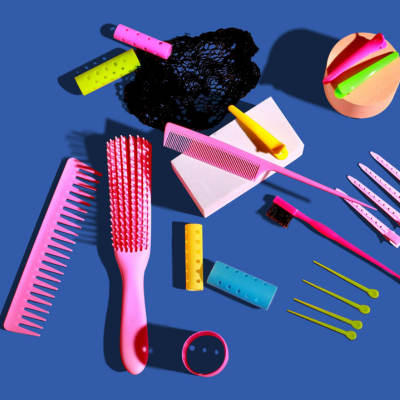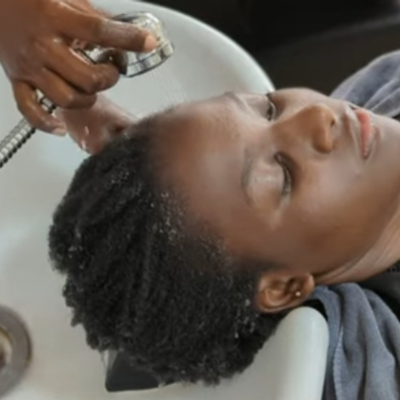- Support 24/7
- +1 (480) 468-4543
- livara@mylivara.com
An Easy Guide To Everything You’ll Need In Your Natural Hair Starter Kit

Slip: Why It’s the Secret Weapon for Healthy, Happy Curls
June 13, 2024
“Why Isn’t My Baby’s Hair Growing?” Everything You Need To Know
June 15, 2024
Big decision alert! You’ve decided to ditch the relaxer and embrace your natural hair – that’s amazing! It’s a leap towards self-expression, healthier hair, and a whole lot of gorgeous curl power. But let’s be honest, the natural hair world can feel like a foreign land at first. Jargon you can’t decipher, product aisles that stretch as far as the eye can see, and techniques that sound like advanced science – it’s enough to make you want to run back to the familiar (but maybe not-so-healthy) routine.
Don’t worry! We’ve all been there. This starter kit is your friendly guide, translating the fancy talk and breaking down the essentials you need to keep your glorious curls happy and thriving. Think of it as your passport to the curl kingdom – a land of supportive tips, endless hairstyles, and a whole lot of celebrating your unique crown. So grab a comfy seat, get ready to learn some amazing things, and most importantly, get pumped to rock those natural curls with confidence! You’ve got this, curl queen (or king)!
Building Your Natural Haircare Arsenal: Essential Products Explained
Now that you’ve embarked on this exciting journey, let’s dive into the essential products that will become your new best friends. Remember, consistency is key, so get ready to establish a routine that works for you and your unique hair type.
1. Gentle, Sulfate-Free Shampoo: Your Scalp’s Gentle Cleanser
- Why it matters: Most regular shampoos contain harsh detergents, called sulfates, to remove impurities from your hair. However, these sulfates can strip your hair of its natural oils, leaving it dry, brittle, and prone to breakage. Natural hair thrives on moisture, so a gentle, sulfate-free shampoo is your best friend.
- What to look for: Look for shampoos labeled “sulfate-free” or “moisturizing shampoo.” These shampoos use milder cleansing agents that effectively remove dirt and buildup without compromising your hair’s natural moisture balance. You’ll love the way our Sapphire Hair Shampoo feels on your scalp and effectively cleanses your hair.
- How to use it: Wet your hair thoroughly. Apply a small amount of shampoo directly to your scalp and massage gently for 1-2 minutes, focusing on areas prone to product buildup. Use your fingertips to work the lather through the rest of your hair, then rinse completely with lukewarm water.
- When to use it: The frequency of washing depends on your hair type, activity level, and styling choices. You can wash your hair with shampoo once every two weeks or more, depending on the state of your hair and scalp.
2. Deep Conditioner: A Nourishing Oasis for Your Hair
- Why it matters: Deep conditioning is a must-have if you want to achieve soft, easier-to-manage hair. They provide intense moisture and nourishment, penetrating deep into the hair shaft to repair damage and prevent breakage. Natural hair, especially curly or coily hair, can be prone to dryness, so deep conditioning is crucial.
- What to look for: Look for deep conditioners rich in moisturizing ingredients like shea butter, coconut oil, or avocado oil. Protein-based deep conditioners can also be beneficial for strengthening your hair, but use them less frequently (once a month or so) as too much protein can lead to dryness and hardness.
- How to use it: After shampooing, apply a generous amount of deep conditioner to your hair, focusing on the ends (the oldest and driest part). Use a wide-tooth comb to distribute the product evenly. You can use a shower cap or plastic wrap to trap heat and enhance penetration. Let the conditioner sit for 20-30 minutes, or according to the product instructions. Rinse thoroughly with cool water.
- When to use it: Use a deep conditioner once a week or bi-weekly, every after a wash.
3. Leave-In Conditioner: Your Daily Dose of Moisture
- Why it matters: Think of a leave-in conditioner as your hair’s daily moisturizer. It provides ongoing hydration, manageability, and helps prevent frizz throughout the day.
- What to look for: Leave-in conditioners come in various textures, from lightweight creams to thicker lotions. Choose one based on your hair type and preference. Look for ingredients like glycerin, or aloe vera which are known for their humectant and moisturizing properties.
- How to use it: Apply a small amount of leave-in conditioner to damp hair, focusing on the mid-lengths and ends. Avoid applying too much near the roots, as this can weigh down your hair and make it look greasy. You can use the L.O.C. method (Liquid, Oil, Cream) for extra moisture retention: apply leave-in conditioner, then a thin layer of oil (like grapeseed or jojoba oil), and finally seal it in with a moisturizer or curl cream.
- When to use it: Apply leave-in conditioner after every wash. You can also reapply a small amount as needed throughout the week to refresh your hair and add moisture, especially if your hair feels dry or frizzy. Apply leave-in treatment after dampening your hair with some water.
4. Moisturizer and Hair Oil: Sealing the Deal on Moisture
- Why it matters: Water-based moisturizers like the Tsavorite Spritz Moisturizer, or even plain old water in a spray bottle are crucial for supplying the hair with the regular dose of moisture it needs to thrive. Hair oils, on the other hand, are the last step in your moisture retention routine. They create a barrier on the hair shaft, preventing moisture from escaping and keeping your curls hydrated throughout the day.
- What to look for: Moisturizers for natural hair should have water as their primary ingredient and should contain hydrating ingredients to effectively moisturize the hair. Hair oils come in a wide range of options, from lightweight argan oil to heavier coconut oil. Experiment to find what works best for your hair type. If your hair is fine or low porosity, opt for lighter oils. Thicker hair or high porosity hair can benefit from richer butters and heavier oils.
- How to use it: Apply an ample amount of moisturizer and thereafter seal in the moisture with a hair oil, focusing on the ends, lengths, and scalp, of course. You can use the L.O.C. method mentioned earlier for extra moisture retention.
- When to use it: Apply a moisturizer or hair oil every few days or as needed to maintain moisture levels. If your hair feels dry in the morning, you might need to apply some more product as needed.
Beyond the Basics: Techniques for Healthy, Happy Curls
Now that you’ve got your product arsenal stocked, let’s explore some techniques to help your curls thrive:
- Detangling: Detangling your hair can be a daunting task, but it’s crucial to prevent breakage. Do it gently while your hair is still wet and loaded with conditioner or moisturizer. Use a wide-tooth comb and work your way up from the ends to the roots to avoid pulling.
- Deep Conditioning Techniques: There are various deep conditioning techniques you can experiment with. Try incorporating heat with a hooded dryer or hot towel treatment to enhance penetration. You can also do an overnight deep conditioning treatment for an extra dose of moisture.
- Styling Techniques: The natural hair world is full of endless styling possibilities! From the classic twist-out to the braid-out and bantu knots, there’s a style for every occasion. Explore online tutorials, get inspiration from platforms like Pinterest, and find techniques that work for your hair type and desired look.
- Protective Styling: Protective styles are a great way to minimize manipulation and retain moisture. Braids, twists, and cornrows are all excellent options. Opt for loose styles to avoid putting tension on your hair.
Accessorize Your Curls with Confidence!
Natural hair accessories are not just about function, they’re a fun way to express your unique style and complement your gorgeous curls. Here are some must-have accessories for your natural hair journey:
- Satin or Silk Scarf/Pillowcase: Cotton can be a moisture thief, so swapping to a satin or silk scarf/pillowcase can significantly reduce frizz and breakage.
- Wide-Tooth Combs & Detangling Brushes: Ditch those small combs! Invest in wide-tooth combs and detangling brushes specifically designed for natural hair to minimize breakage during detangling.
- Bobby Pins & Hair Clips: Bobby pins and hair clips are your best friends for creating updos, twists, and bantu knots. Opt for large, U-shaped bobby pins for better hold without damaging your hair.
- Scrunchies: Scrunchies are a gentle alternative to hair ties that help prevent breakage and pulling.
- Headbands & Head wraps: Headbands and head wraps are stylish accessories that can help control frizz and flyaways. They come in a variety of colors and patterns to match your personal style.
Remember: Your natural hair journey is unique. Embrace the learning process, experiment with different products and techniques, and most importantly, have fun! There will be good hair days and bad hair days, but with a little patience and dedication, you’ll be well on your way to unlocking the full potential of your gorgeous curls. Because you are a GEM.



